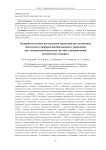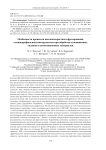Статьи журнала - Siberian Aerospace Journal
Все статьи: 363

Статья научная
Transport operations that ensure the change of the orbit of a spacecraft or its transfer to the departure trajectory are an integral part of almost all space missions. Increasing requirements for the efficiency of transporting spacecraft form the need to search for possible ways to increase this efficiency and assess the characteristics associated with the proposed methods. Current boosters and interorbital tugs, as a rule, use a chemically powered cruise engine, although solutions with the use of an electric jet engine are becoming more common. Due to the high rate of the outflow of working fluid which is much higher than that of combustion products in a chemical engine, the efficiency of use of the substance mass by an electric jet engine significantly exceeds this indicator for a chemical engine. However, the low thrust provided by the electric jet engine leads to high duration of the transport operation and, as a result, to considerable time of exposure to the outer space factors, in particular, radiation. Therefore, the use of the electric jet engine only does not always meet the requirements for the mission. One of the promising ways to increase the efficiency of transport operations is the combination of the traditional chemical and electric jet engines in the propulsion system. Various aspects of the use of such an integrated propulsion system (IPS) consisting of a solar electric jet system and “Fregat” booster were considered, for example, in the framework of “Dvina TM” research project. Unlike a chemical engine, in which energy is released from chemical bonds, the energy for accelerating the working fluid by an electric jet engine is supplied from outside. Solar batteries are the most widespread energy source in nearearth orbits, where the amount of solar radiation is sufficient to meet the energy needs of a spacecraft. Solar batteries are sensitive to radiation, damage accumulates in their internal structure and their characteristics degrade. Therefore, there is a need to account for the radiation dose accumulated during the execution of the transport operation and to evaluate the reduction in the efficiency of solar batteries. Uneven irradiation intensity in the radiation belts formed by the Earth’s magnetic field (Van Allen belts) can be taken into account if the assessment of the radiation intensity at the trajectory points of the maneuver is made using the Earth radiation belt model. The paper proposes a method that allows taking into account the effect of ionizing radiation on the degradation of solar batteries when performing a transport operation using an integrated propulsion system based on a liquidpropellant rocket engine and an electric jet engine, taking into account the chosen trajectory and the model of the Earth’s radiation belt.
Бесплатно

Estimation of the number of aperiodic words
Статья научная
In 1902 W. Burnside raised the issue of local finiteness of groups, all elements of which are of finite order. The first negative answer was obtained in 1968 in the article by by P.S. Novikov and S.I. Adian. Finiteness of the free Burnside group of period n was established for n = 2, n = 3 (W. Burnside), n = 4 (W. Burnside, I. N. Sanov), n = 6 (M. Hall). The proof of infinity of this group for odd n ≥ 4381 was given in the article by P. S. Novikov and S. I. Adian (1967); for odd n ≥ 665 in the monograph by S. I. Adian (1975). In relation with these results we consider the set of m-aperiodic words. Word is called l-aperiodic if there are no non-empty subwords of the form Yl in it. In the monograph by S. I. Adian (1975) the proof of S. E. Arshon (1937) of the fact that in the two-letters alphabet there is an infinite set of arbitrarily long 3-aperiodic words was shown. In the A.Yu. Olshansky’s monograph (1989) the theorem on the infinity of the set of 6-aperiodic words was proved, and a lower bound function for the number of words of a given length was obtained. Our aim is to get an estimate for the function ()fn of the number of m-aperiodic words of the length n in the two-letters alphabet. The results can be applied when encoding information in space communications.
Бесплатно

Статья научная
The article discusses the prospects of utilization of aerodynamic control to maintain the formation of nanosatellites of the CubeSat class. The purpose of this work is to estimate the limits of the application of active aerodynamic control to stabilize the relative motion of two CubeSat 3U satellites in a sunsynchronous orbit with a height of 570 km. A review of theoretical information about aerodynamic forces acting on artificial Earth satellites is carried out, within the framework of which models of the Earth's upper atmosphere are considered. Aspects of creating a differential drag force for nanosatellites as an active control actuating mechanism are considered. To study the orbital motion of satellites under the action of aerodynamic control using the General Mission Analysis Tool program, a group flight of two spacecraft was simulated taking into account the factors causing orbital disturbances. Based on the results of experiments, the dynamics of the inter-satellite distance was studied, and a conclusion was made about the possibility of using an aerodynamic differential force to achieve a stable relative motion.
Бесплатно

Статья научная
The prospects for the development of space technology are currently closely connected with the creation of fundamentally new large-sized space structures. When designing large-sized systems, the scheme of which allows for automatic configuration change of the structure, it is necessary to take into account shock loads. They inevitably arise when fixing the working state of the structure in orbit upon completion of the process of its opening. To ensure smooth, reliable and shock-free opening of large-sized space structures, it is proposed to use force drives with active elements made of titanium nickelide material with a shape memory effect. The proposed shape memory force actuator uses an active element in the form of a wire made of titanium nickelide material which is heated during opera-tion by passing an electric current through it. One of the main parameters for the opening drive of large-sized structures is its deformation-force characteristic. Experimental studies aimed at studying this characteristic of the active element of the actuator were carried out in the work. The study of the force-deformation characteristics was carried out under two types of loading: in one, the force changed during the test, and in the other it remained constant. It is worth noting that the amount of deformation that an active element can produce is directly related to the magnitude and nature of the resistance force applied to it. In the experiment, the active element demonstrated sufficient displacement under significant load. The experimental data obtained show the fundamental possibility of using active elements made of a material with a shape memory effect in the opening drives of large-sized space structures. The obtained characteristic will play an important role in the development of a mathematical model of the functioning of an active element made of a material with a shape memory effect for the opening of a space structure with transformable configuration.
Бесплатно

Evaluation of the main parameters of ReshUCube-1 telemetry over a period of 10 months in orbit
Статья научная
With the increase in the number of launched spacecraft, such a direction as automation of spacecraft control processes is gaining popularity. One of these most important processes is the analysis of telemetry data during the operation of a spacecraft. Scientific and educational satellite of the Reshetnev Siberian State University of Science and Technology has been successfully exploitated in orbit and has been performing its scientific tasks for more than six months. The article considers a list of the main parameters analyzed by the operators of the Mission Control Center to assess the state of the ReshUCube-1 satellite. The composition and main functional characteristics of the equipment on the spacecraft are described. Qualitative indicators and quantitative limits for all described parameters are given, as well as their significance and impact on the functioning of devices and the entire spacecraft as a whole.
Бесплатно

Статья научная
The development of new ballistic-type aircraft is characterized primarily by improved aerodynamic characteristics and higher speed limits. Ground track testing of aviation and rocket technology is a stage whose task is to confirm the efficiency and effectiveness of new developments. Track tests make it possible to simulate real loads, they are simpler and much cheaper than flight tests. Experimental installation "Rocket rail track 3500" of Scientific Test Range of Aviation Systems named after L. K. Safronov is constantly being upgraded in order to conduct track tests of products at a speed greater than 3M. The experimental setup includes a two-rail track, made on a special foundation, which excludes unacceptable rail deflection with a mass of up to 3000 kg. The rail track has an acceleration section with an angle of attack 2500 m long and a deceleration section. A tray filled with water is made on the braking section between the track rails. It is designed for hydrodynamic braking to a complete stop of the rocket sled with stored equipment. The movable rocket track sled is made of a massive steel plate to which three cross beams are welded. The front and rear beams end with axles on which sliding supports are pivotally mounted. On the rear and middle beams there are lodgements for fastening rocket engines of solid fuel. Depending on the required test speed, from one to five motors can be placed on the cradles. The test object is usually mounted on the front and middle beams along the axis of the sled and fixed in a cantilever, with the head part extended forward. The design of the supports – shoes is made to encircle the rail head in such a way that it provides sliding contact along the upper plane of the rail head, and in the event of a lifting force exceeding the weight of the sled at high speeds, it keeps the structure from free flight by contacting the lower surface of the rail head. Track high-speed tests of special equipment objects are always accompanied by intense vibration and shock effects of structural elements. Due to the desire to conduct track testing of products at a faster rate, it becomes necessary to reduce the level of dynamic loads and eliminate resonant interactions. The article presents an algorithm and methodology for statistical processing of random signals of three-axis vibration acceleration sensors installed on the shoes of the rocket track sled and on the fairing of the test object. Due to the placement of registration data storage devices on the sled, experimental vibration data were stored when testing the product at a speed of more than 1M. The autocorrelation functions of the signals of vibration accelerations of sensors placed on various elements of the rocket sled, the functions of mutual correlation of the corresponding signals, the density of the amplitude spectra, the density of the power spectra and the transfer functions that characterize the dynamic conductivity of vibrations from the shoes sliding along the rail guides to the test object were determined.
Бесплатно

Статья научная
Electro-jet (plasma or ion) thrusters are becoming increasingly common to correct a satellite orbit and perform orbit raising maneuvers to achieve the geostationary orbit. This is due to the greater efficiency of plasma thrusters compared to chemical ones. When developing a satellite platform, an important place is the matching up of the electrical character-istics of the electric power subsystem (EPS) and on-board consumers. Intrinsically, this issue is an intersys-tem problem. The lack of proper attention paid to find the timely and correct solution of this problem can complicate the operation of the satellite electric power subsystem. The most important subsystem, which has a significant impact on the operation of the satellite EPS, is the electric-jet propulsion subsystem, since among on-board consumers, this one is the most powerful consumer being switched simultaneously. Tran-sients occurred in the power supply circuits following thruster firing and shut down processes can reach significant values. An electric jet thruster only runs in conjunction with a complex electronic unit – a power processing unit (PPU), which converts the voltage of the on-board power supply into a set of voltages nec-essary for thruster components to run. Therefore, in the preliminary design of the propulsion subsystem, it is necessary to know the electrical characteristics of transients and ripples in the power supply circuits of the thruster / PPU combination being an electrical load of the Electric power subsystem. It is difficult to obtain the characteristics of such processes by the calculation method. Therefore, an experimental method is the most common and objective method to obtain this information. JSC ISS carried out tests allowing to measure characteristics of transients and ripples under firing, running and shut down of plasma thrusters of different types powered by corresponding PPU’s. These tests were conducted using a vacuum chamber GVU-60. A test power supply was used to simulate EPS operation. This paper presents the results of meas-urements and analysis of parameters of transients and ripples on PPU power buses used for thrusters and devices of three types. These results are considered to be preliminary. It is shown that the greatest difficul-ties can arise when operating high-power thrusters. It is concluded that for each new type of thrusters and PPU’s it is advisable to conduct interface tests of the propulsion subsystem and the satellite electric power subsystem.
Бесплатно

Статья научная
In this paper the approach for external boundary of pole localization region formulation for transfer function with interval-given parameters is proposed. The boundary is formulated as analytic piecewise function of characteristic polynomial parameters of the given transfer function. Analytic formulation of external boundary of poles localization region allows to reduce computations since existing methods require iterative numeric calculations of characteristic equation roots with fixed step size for edges mapping or full interval root locus mapping as well. Formulated boundary allows to clearly describe system behavior and calculate variation ranges of performance indexes. In addition, piecewise function that constrains gives new opportunities for parametric controller synthesis for systems introduced by transfer functions with interval-given parameters. The results can find its practical application in aerospace engineering problems of mathematical analysis and synthesis for highly-precise systems of self-direction missiles. In the research the boundary formulation is performed for third order transfer function. Transfer function order was chosen due to the fact that many physical systems and objects can be described mathematically with the third order transfer function, e.g. model of missile target-seeking head with gyro stabilized drive is described with this model. The research was performed on the basis of the following step sequence: firstly, analytical solving of cubic equation applying Cardano’s formula; secondly, interval root locus edges functions obtaining, next external vertexes set obtaining and, finally, external border formulation and plotting.
Бесплатно

Factor analysis of inelastic electron scattering cross section spectra of iron monosilicide FeSi
Статья научная
The inelastic electron scattering cross-section spectra of FeSi silicide were calculated from the experimental reflected electron energy loss spectra as the product of the average inelastic mean free path and the differential cross section of the inelastic electron scattering. To inelastic electron scattering cross-section spectra study, factor analysis was used. This method allowed us to quantitatively separate the surface and bulk contributions to the spectra, and determine the energy of the bulk plasmon more accurately than it is possible using traditional methods. Inelastic electron scattering cross-section spectra (Kλ-spectra) are the products of the average inelastic mean free path λ and the differential inelastic scattering cross-section K (E0, E0 – E), where E0 and E are the energies of the primary and reflected electrons, respectively. The advantage of inelastic electron scattering cross section spectroscopy is that, unlike the reflected electron energy loss spectra, the Kλ-spectra exclude losses due to multiple excitations, and the intensities are determined in absolute units. These spectra are also more sensitive to changes in the energy of the primary electrons and the angle of emission. Inelastic electron scattering cross-section spectroscopy allows to determine the element composition with much greater accuracy than the traditional method of reflected electron energy loss spectroscopy. In this work, factor analysis is used to study the inelastic electron scattering cross section spectra of the FeSi silicide. This method allowed to solve the actual problem of separating spectra into contributions of a different origin, quantify them and determine the energies of a bulk plasmon more accurately compared with traditional methods. The study of electron energy loss processes by isolating contributions of different origin in the inelastic electron scattering cross section spectra is one of the urgent problems of electron spectroscopy, which can be used to assess the effect of surface excitations in REELS, XPS and AES.
Бесплатно

Статья научная
During the liquid rocket engines (LRE) testing, direct thrust measurement is carried out using thrust measurement devices. The aim of the work was, on the basis of existing data from the theory of tests and test stands devices, to highlight the design features of the thrust measurement devices and propose an option to improve the performance of this stand system. The work considers the basic circuit power schemes of thrust measurement devices by the example of power measuring systems of existing fire test stands and the features of work on preparing systems for testing. The types of calibration systems worked out in practice, their advantages and disadvantages, which constitute calibration errors, are considered. An option is proposed to modernize thrust measurement devices, in particular, through implementing of an electromechanical drive based on a planetary roller-screw mechanism as a force setting element into the calibration system. A possible general conceptual diagram of the power drive operation as a part of the calibration system of the thrust measurement devices is given. The advantages and disadvantages, the predicted effects of implementation are considered. A more detailed analysis of this proposal may serve as an occasion for the modernization of the specific operational thrust measurement devices design at the fire test stand for LREs or may be a working option when designing a new thrust measurement device.
Бесплатно

Features of electroactivated water production at a coaxial electrode location
Статья научная
Important characteristics of any product are quality and reliability. One of the factors affecting product reliability is the surface cleanliness provided by flushing with liquids. Electroactivated water and aqueous solutions can be used as liquids. On the basis of domestic and foreign experience, leading experts have developed methodological instructions for the widespread implementation of electro-activated water and aqueous solutions in instrument-making and mechanical engineering. For the production of electrochemically activated water and solutions, non-flowing and flowthrough modular elements, as well as universal installations, have been developed. Analysis of the structures of these devices has shown that flat metal plates are used as electrodes, therefore there are volumes of water that are subjected to uneven electrical effects. As a result, the specific energy consumption for obtaining activated water is significant. The purpose of the work is to reduce the specific energy consumption in the production of activated water and aqueous solutions. Coaxial arrangement of the electrodes leads to reduction in energy consumption. The study of the electroactivator of water with a coaxial arrangement of electrodes allowed us to establish the optimal ratio between the volumes of anolyte and catholyte and the time of electrolysis of water and an aqueous solution of sodium chloride. A new indicator of efficiency (the specific energy consumption per unit of change in the pH of water or an aqueous solution) objectively reflects the perfection of the design of electroactivators. The research results can be used in instrument and mechanical engineering.
Бесплатно

Features of modeling the electron beam distribution energy for the electron-beam welding process
Статья научная
The energy distribution of the electron beam by means of application of various scanning paths, affects for-mation of the weld, which relates to the quality of the welded joints. Experimental studies, conducted by the au-thors of the article showed that scanning the electron beam in the form of a raster shape gives the best quality of welded joints; therefore, the trajectories of a classical raster and a truncated raster are proposed for the elec-tron beam welding process. When conducting research in this direction, the authors discovered the following regularity: with an increase in the scanning amplitude along the junction, the vapour-gas penetration channel transforms into a stable cavity, along the front wall of which the metal melts, and along the side walls it is trans-ferred to the tail of the weld pool. The discovered effect of the formation of a penetration cavity is to be investigated in electron beam welding of various materials and thicknesses. For this the necessary equipment is to be created, allowing to make scan-ning in the form of various rasters. To improve the quality of the electron beam welding process, trajectories of a classical raster and a truncated raster across the joint are proposed. For these scanning trajectories, analytical expressions and families of calculated characteristics of the electron beam energy density distribution over the heating spot are obtained. Modulation of the electron beam oscillation in the form of a truncated raster across the junction makes it possible to obtain a two-humped distribution of the beam energy on the surface of the part along the heating spot. The obtained characteristics allow a more meaningful approach to optimizing the pro-cess of electron beam welding of various materials.
Бесплатно

Статья научная
Complex computational and experimental studies substantiate rational modes of milling of complex contour equiaxed surfaces with high accuracy of shape, dimensions and roughness parameters. Bars made of nanostructured carbide composite (produced by extrusion of WC-Co-Al2O3 bimodal powder mixtures) with increased strength, crack resistance and heat resistance were used as a workpiece material for the manufacture of new original tool designs. The combination of these properties is a necessary prerequisite for the effective operation of the developed designs of multi-blade cutters at high cutting speeds and under conditions of variable cyclic loads. A more complex kinematics of the joint rotational movement of the tool during milling dictates the need for new approaches when assigning rational cutting modes. To obtain reliable calculation formulae, numerical experiments were previously carried out, including simulation of the machining process using the VisualStudio integrated development environment, which supports Windows- Forms technology. The ability to display graphical 3D objects was implemented using an additional software product in the form of the Open CASCADE geometric core. Numerical experiments using MathCAD software products and based on the analytical provisions proposed in the work made it possible to evaluate the influence of cutting conditions, geometric parameters of the cutting part of the tool (profile and number of teeth), kinematics of relative movement in the “tool – part” system on the shape of surfaces and contour parameters (roughness) obtained during milling. A technique, algorithm and program for the automated calculation of cutting conditions have been developed, which have been verified during full-scale experiments and the manufacture of complex profile parts from aluminum alloys for drives of aerospace products (in the form of an equiaxial profile and parts of a pinion transmission of guidance mechanisms). At the same time, on the basis of a 3D model of products, control programs for CNC machines were created using MasterCAM. The practical significance and technical and economic efficiency of the proposed design and technological solutions is to increase productivity and reduce the complexity of processing (in comparison with the basic options) through the use of new multi-edge carbide tools for high-speed milling (including when processing composite materials).
Бесплатно

Features of reaching limiting speed values of track tests of ballistic type aircraft
Статья научная
The development of high-speed ballistic aircraft with speeds exceeding 1000 m/s is currently a priority abroad and in Russia. The effectiveness of new such products is confirmed by track tests at the speed of their use. Test sites with rail tracks exist in almost all countries, for example in the USA there are more than 15 of them. Double-rail, monorail and various combinations thereof, differing in length, width of the rail pair, rails and the design of the track itself, including a sealed shell over the rail track to fill it with a lighter one environment. The longest track in the USA is Holloman AFB, located in New Mexico with a length of 15536 m. They have track ranges with different lengths and their own special design in England, France, Germany, Canada, Italy, Japan, India, China, Korea, Turkey and other countries, including African continent. Highspeed range tests in Russia are carried out on the experimental installation “Rocket Rail Track 2500”, located on the territory of the FSE “Scientific test range of aviation systems named after L.K. Safronov”. The experimental installation consists of a rail track placed on a special base, providing the necessary vertical profile of the track with sections of ascent and straight horizontal movement, as well as a technological descent section for braking moving technological equipment. The product under test is placed on a rocket track sled moving along rails on sliding supports. To accelerate the track carriage, solid fuel rocket engines are used, the thrust of which is selected based on ballistic calculations to achieve the required test speed. The length of the track plays an important role in achieving the maximum acceleration speeds of moving track equipment. The enormous aerodynamic drag, proportional to the square of the speed of movement of the carriage, when tested at high speeds, leads to the need to reduce the midsection and mass of the mobile unit. An increase in engine thrust leads to an increase in the weight and cost of track equipment, as well as to the need to increase the safety margin of sliding supports. However, an increase in test speed can be achieved by replacing the air medium with gases that have a significantly lower density, for example, helium. Track testing of new aircraft or their elements, although cheaper than flight testing, is quite expensive. In this regard, work on the theoretical assessment of replacing the medium from ambient air with helium, as well as with a mixture of helium and air at different concentrations in an indoor gallery on a track rail track, is a new, relevant and practically useful task. The work performed a numerical simulation of the problem of supersonic flow around a helium-air mixture at different volumetric ratios. Numerical values of aerodynamic resistance were obtained at a sled speed of 830 m/s. The results of numerical calculations of the motion dynamics of a 3D model of monorail track equipment, which are planned for use in conducting full-scale fire experiments, are presented.
Бесплатно

Статья научная
This article addresses the Express-RV satellite system, which developers are currently creating. Its primary purpose is to provide subscribers in the Russian Federation and the Northern Sea Route with internet access. The subject of the study is the main features of the Express-RV system implementation, concerning communication in the forward and reverse satellite channel. Among the main features of the satellite system, in addition to the highly elliptical orbit (HEO), we can highlight multi-beam coverage of the service area, direct signal retransmission and the choice of DVB-S2X and DVB-RCS2 satellite communication standards. To implement multi-beam coverage of the service area and direct retransmission, the system employs a multi-beam Ku-band payload. Therefore, the work prioritizes the description of this payload. Objective of the work: to analyze the features and energy parameters of the Express-RV satellite system to confirm its operability, as well as to determine the operating modes in the forward and reverse channels according to the DVB-S2X and DVB-RCS2 standards. Methodology: analysis of the main solutions of the Express-RV system being developed, the DVB-S2X and DVB-RCS2 satellite standards and the recommendations of the International Radiocommunication Union ITU-R P.618-13, theoretical calculation of the energy budget of the radio link. The results confirm the system’s operability, as the study demonstrates the possibility of quasi-error-free reception of DVB-S2X and DVB-RCS2 signals under ideal synchronization conditions. In addition, based on the calculation, we identify the actually used types of modulation in the return channel from those presented in the DVB-RCS2 standard for 3 types of subscriber terminals. For the forward channel, the analysis reveals that the transmission mode adapts to the terminal with the smallest reflector diameter, eliminating benefits from larger-aperture terminals. Scope of application of the results: the researchers and engineers use the results to further develop the Express-RV satellite system.
Бесплатно

Flexible composite structures with controlled physical and mechanical characteristics
Статья научная
The article presents the results of theoretical and experimental studies that are the basis for the devel-opment of a new class of aerospace engineering structures that allow implementing approaches to create structures with variable morphological and functional characteristics of products. Condensed soft sub-stances, such as elastomers, gels, gradually become functional elements on the basis of which the creation of soft machines and electronics develops [1–3]. Research in this direction has led to the creation of struc-tures with a special architecture that are mechanically compatible, deformable and capable, with a certain combination, of perceiving and transmitting a signal, changing their shapes and physical characteristics (thermal conductivity, electrical conductivity, etc.). The use of such structures in a certain sense models the multifunctionality observed in biological objects and structures (skin, muscles, nervous tissue) [4–7]. The creation of structures that change their shape, structure and change their functional and operational char-acteristics in the process of work, taking into account changing external and internal conditions, is an ur-gent task for many systems of aerospace technology. In this paper, morphologically changeable structures are considered, which include reconfigurable antennas, aircraft wings with variable shape and geometry, flexible robotic systems [8]. The use of such systems with flexible structural elements makes it possible to create structures capable of overcoming unpredictable obstacles due to their adaptive geometry, fit into limited spaces and withstand significant loads and vibrations. One of the most important tasks in the devel-opment of such systems is the organization of a distributed actuation system associated with the problem of creating an internal structure of actuators integrated into a flexible composite design of actuators made of elastic materials. In a number of works for the operation of thermoactive actuators, the use of rigid nano-particles as surface heating elements or as fillers for composites that are electrically sensitive, magnetical-ly sensitive and/or photoreactive has been investigated [9–13]. However, surface heating elements are lim-ited in use beyond a thickness of several hundred micrometers due to their low intrinsic thermal conductivi-ty [14]. In addition, rigid components significantly change the mechanical properties of the structure being created, which limits the morphological capabilities of the structures being created. For example, in [15], it is shown that reducing the electrical resistance for a thermal heater to acceptable values requires an increase in the filler to 15% of the mass of the structure, while the deformation of the actuation of the struc-ture is reduced by 35.0%. In this paper, overcoming the above limitations is carried out by creating a ma-terial architecture that dramatically expands the range of properties and dynamic functions of the heating element being developed for the actuator. Multifunctionality is achieved by embedding metal fibers of a certain configuration into an elastic medium based on polydimethylsiloxane elastomer, which provide mo-bility and conformality of the deformable structure of the actuator during its operation. It is shown that the inclusion of metal fibers of a certain configuration in the structure of the actuator does not interfere with its ability to change shape and perform mechanical work in response to external stimuli. Shape morphing in the absence of an external load can be programmed in the composite structure by including fibers with certain stiffness and thermal characteristics in it so that it can reversibly switch between programmed morphologies using electrical or thermal stimulation. Together, these properties allow the composite to demonstrate a rich variety of functionality, which allows it to simultaneously realize sensory and dynamic characteristics.
Бесплатно

Flight efficiency of solar thermal propulsion with double-stage thermal energy storage
Статья научная
The activity urgency is connected with requirement of heavy spacecraft ascent into high work-ing orbits. The solar thermal propulsion (STP) with double-stage latent heat thermal energy storage (TES) is intended for space vehicle delivery into geostationary orbit (GEO). Double-stage TES contains peripheral stage as “solar concentrator – sunlight absorber-thermal energy storage” system (CATS) with relatively low-temperature heat-accumulating phase-changing material (HAM) having high latent heat of fusion, for instance, lithium hydride, and high-temperature central stage with high power-intensive TES, for example, beryllium oxide, that allows to obtain high specific impulse 900 sec. Inter-orbital transfer time from low earth orbit (LEO)-to-GEO varies from 20 to 90 days. Expedient optical-energetic characteristic parameters of the STRE for each flight time shows that expedient accuracy of the solar mirror concentrator is much less in comparison with single-stage CATS with beryllium oxide as the HAM, therefore, the CATS Sun tracking conditions can be significantly simplified. Comparison between the STRE and alternative means of inter-orbital transportation shows that payload mass on GEO seriously exceeds that for liquid propulsion or combined upper stages with both chemical and electric propulsion. Use of the STRE with heated hydrogen after-burning allows payload mass to increase at relatively low transfer time, as well as reduce space vehicle dimensions and the CATS complication. The expedient oxidizer-to-fuel mass ratios depend on LEO-to-GEO trip time. The considered possible variants of payloads – geostationary communication satellites – can be injected into the target orbit with use of “Soyuz-2.1b” middle class launchers having the “solar” upper stage instead of “Proton-M” heavy rockets class with chemical liquid-propellant kick-stages.
Бесплатно

Flow dynamics in the radial-annular cavity of turbomachines
Статья научная
This paper considers the problem of modeling a rotational flow in the radial-annular cavity of turbo machines with fixed walls. This case corresponds to the boundary conditions of the supply channel for a radial centripetal turbine. In the presented model, the flow is conventionally divided into radial and circumferential movement. The radial component of the velocity is determined by the mass flow rate from the continuity equation, the circumferential component is formed by the tangential channel supply. The main equation in the integration is the equation of the change in the momentum for the flow in the form of the Euler equation. In the case of the circumferential component of the velocity, the angular momentum law is used, assuming the potentiality of the flow and the constancy of the angular momentum within the integration step. As a result of the transformations of the motion equations, differential equations for the radial, circumferential component of velocity and static pressure are obtained, which represent a certain system of three equations in three unknowns. The system of equations allows integration under known boundary conditions at the inlet; as a result of integration, it is possible to obtain the field of distributions of velocities and pressures along the radius of the radial-annular cavity. The results of the study can be used in modeling the circumferential and radial forces on the rotor (impeller) of turbo machines.
Бесплатно

Flow model in the impeller of a centrifugal pump
Статья научная
In accordance with the results of the features analysis of foreign design technology and the creation of aerospace technology products, the certification orientation of all types of work can be traced, starting from the preliminary design stage, which imposes particularly high requirements on the quality of calcula-tion methods, algorithms and software used in the design development of the project. Without the advanced level of domestic developments in the field of modeling hydrodynamic processes in aircraft systems, in the next decade it will become impossible to compete with foreign developers of aviation and rocket-space sys-tems. In accordance with modern theoretical and experimental studies, the flow pattern in the flow path of a vane machine is a complex superposition of the main and secondary flows. The article discusses the method for calculating the fluid flow in the interscapular channel of a centrifugal impeller with a finite number of vanes, the construction of the energy characteristics of the impeller and its optimization by the number of vanes. The calculation consists of two parts: firstly, the determination of the theoretical head taking into account the influence of the finite number of vanes based on analysis of force interaction, and, secondly, determination of hydraulic losses in the impeller by integrating friction stresses along the limit-ing surfaces. The results from both parts are used to optimize the number of vanes in the pump impeller. Analytically, an equation for the pressure at a point and the coefficient of influence of a finite number of vanes are obtained. Taking into account the law of friction, an expression was obtained for the pressure loss. The described method for calculating the spatial boundary layer is quite simple and intuitive, and gives approximate results that make it possible to estimate the required quantities. However, there is a need for further elaboration of the method to bring it to a form that makes it possible to calculate the three-dimensional flow of the working fluid in a channel of arbitrary shape. Based on the results of theoretical studies, an algorithm and a calculation program were developed that allow calculating local values. The results of the calculation of the theoretical head in the impeller can be used for a more accurate calcula-tion of a centrifugal pump.
Бесплатно
![Formation features of the central layers of the alloy Fe – 3 % Si (110)[hkl] rolling textures Formation features of the central layers of the alloy Fe – 3 % Si (110)[hkl] rolling textures](/file/thumb/148321699/formation-features-of-the-central-layers-of-the-alloy-fe-3-si-110-hkl.png)
Formation features of the central layers of the alloy Fe – 3 % Si (110)[hkl] rolling textures
Статья научная
The fields of solid-state physics, metallurgy, plastic deformation, mathematics and continuum mechanics are engaged in the studies of texturing of metals and alloys and their influence on the operational properties of products. As a rule, the most significant results are expected at the interface between these sciences. The technologies of obtaining textured materials by metal forming processes occupy a special place in the metalworking sphere. This is due to promising directions in technologies for producing semi-finished and final products with improved structure-sensitive properties, by regulating the texturing, taking into account initial crystallographic orientation of the workpiece. The first issue to note is the formation of an ideal, one-component crystallographic texture in anisotropic metallic materials. The second issue is to obtain semi-finished and final products with more specific service properties: crystallographic texture with specific predetermined components. For instance, due to the crystallographic texture, it is possible to increase the resistance of metals and alloys against corrosion and hostile environment. Considering textured materials as composite, we must note that directionally oriented crystallites with crystallographic directions relative to the laboratory direction perform as reinforced elements. The initial texture in the processing plane is especially important. The materials, which possess unique structure-sensitive properties acquired through pressure treatment, are very promising for a widespread use in the sphere of aerospace technology. Obviously, the properties and means of their achievement are diverse and require setting a specific task. Therefore, further research in this sphere is especially promising. The article presents the research findings, considering the effect of initial crystallographic orientation and deformation modes on the rolling texture in the central layer of Fe – 3% Si (110)[hkl] single crystals. Several groups of single crystal samples underwent rolling under laboratory conditions. The groups of samples were classified according to the final deformation rate, the ideal crystallographic orientation of the rolling plane and deflections of the ideal orientation plane direction from the rolling direction. The methodology of the experiment took into account the compression rate value during one rolling. We analyzed the results of rolling, using the radiographic method. The next step was to superimpose the radiographic data on a stereographic projection and to construct straight pole figures. The results of straight pole figures decoding revealed differences in the texture formation from the previously obtained data. The research shows the manifestation of the one-component deformation texture in the central layer.
Бесплатно

